Registered with the Registrar of Newspapers for India under R.N.I 53640/91
Vol. XXVI No. 24, April 1-15, 2017
Rambling in our museums (2) … with N.S. Parthasarathy
A ‘period’ museum – A glimpse of a historical era
The Fort Museum established in 1948 in the Exchange Building, a historic protected building in Fort St. George, seems to draw visitors even on a working day afternoon. It was a pleasant surprise to see well over 150 visitors going round the exhibition rooms. They had to jostle and try for enough time to appreciate the value and significance of each exhibit.
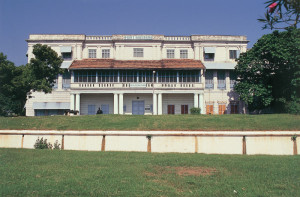
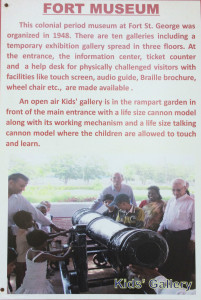
The museum is a period museum distinct from, say, history, art or cultural museums, its theme being the colonial period; it exhibits only artefacts relating to that period. The museum began with a small collection of objects of the East India Company and subsequent colonial items donated by the then Madras Presidency Government, the St. Mary’s Church authorities, the disbanded army units and others. With subsequent acquisitions, over the years, there are now 3,661 registered antiquities in the collection.
The antiquities are displayed in ten galleries spread over three floors. An imposing marble statue of Lord Cornwallis (1738-1805) dominates the entrance to the museum. The base of the statue depicts the scene of surrender of two sons of Tippu Sultan to the British as hostages.
In the Porcelain Gallery what strikes the visitor is the porcelain tableware of the 17th Century used by the top officials of the East India Company and those of the Arcot Nawab. They are striking for their designs – the two distinctly different in motif – their enormous size, and their durability over the years.
In the Portrait Gallery, the oil paintings include those of George III and his consort, Queen Victoria, and Robert Clive. Another noteworthy painting is the earliest depiction of Fort St. George (1738).
In the Miscellany Gallery, on display is the silverware donated by Elihu Yale. Also of interest are the enormous locks for the gates of the Fort – apparently implying a belief that assurance of security was in direct proportion to the size of the locks – and a palanquin of the Arcot Nawabs.
In the Prints and Document Gallery, there is a fine display of drawings by the famous Thomas Daniell and his nephew William. Important among the documents are some original letters of Robert Clive and other historic figures. An 8 cm x 12 cm Book of Common Prayer printed in 1746 and The Bible printed in 1660 and used by Streynsham Master, Governor of Fort St. George, who was responsible for the building of the oldest Anglican Church east of Suez, St. Mary’s in the Fort. Handwritten, large size Church Registers of Baptisms, Marriages and Burials (1680-1786) are well preserved.
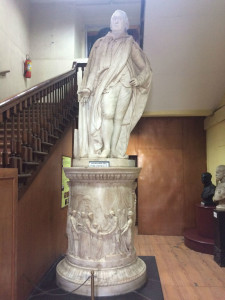 Cornwallis and the hostage taking.
Cornwallis and the hostage taking.
The Indo-French Gallery contains exhibits like fine, decorated porcelain, clocks, stamps and coins issued by the French in India, as well as furniture, lampshades and clocks. Artefacts from the Wodeyars, of Mysore, such as portraits, paintings of the Mysore School, coins, flags and appreciation letters are on display in the Wodeyar Gallery.
In the Weapons Gallery, you can see the progress in weaponisation, starting with battle axes, daggers and swords for direct engagement to distant engagement weapons, progressing from pistols, rifles and mortars, to cannons and shells fired from ships, to bombs dropped from the air. The fragment of a shell fired by the German cruiser Emden on 22-9-1914 and those of a bomb dropped on Madras by a Japanese aircraft in 1943 during World War II are particularly popular with the senior citizens of today. Uniforms and regimental colours displayed are striking for their colour combinations and elaborate designs, all meant to inspire in the citizens a sense of security, of being well protected, besides awe and pride.
There is evidence of many improvements to the technology and style of display since the writer’s last visit several years ago, taking round an English guest. There is a vast improvement in lighting effects consistent with conservational needs. To ensure the needs of certain objects, like original paintings which are sensitive to temperature and exposure to light, controlled lighting is now adopted and monitored with meters to measure the glare and adjusted manually according to the prevailing natural light and conservational norms. Direct contact with nails or metal objects is avoided for all exhibits, especially metallic exhibits like weapons and shields, by placing or propping them on acrylic supports. Guide notes in Braille are placed at all displays. Above all, the precincts are maintained in an excellent state of tidiness.
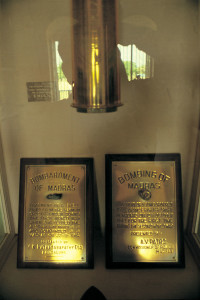 Memories of the Emden and the World War II’s lone bomber over Madras.
Memories of the Emden and the World War II’s lone bomber over Madras.
To enliven their experience, children and students are provided attractions in the form of a “talking” cannon and a rotating cannon. The young visitors are free to handle and manipulate these devices to learn more about them. Admission is free for this class of visitors. Entry fee for elders has been kept very low to encourage attendance. I was told that this was unlike the practice in museums in developed countries which recover a good part of upkeep expenses through substantial admission fees, and still attract a large audience. Enquiries showed that fund availability is not a problem for routine maintenance and replacements nor for major improvements.
To enlarge its collection, however, the museum depends on contributors who possess old documents or souvenirs relating to that period. Response from potential contributors has been feeble and, as such, much of what is exhibited tends to be very much unchanged, making repeat visits superfluous. One way to attract original and repeat visits could be through supplements like documentaries, interesting lectures, special events and programmes of re-enactment of historical episodes that centre on the Fort.
The museum is managed by the Archaeological Survey of India, Museum Branch, Southern Region. The present Curator has been in office for ten years or so, saving this museum from the usual problem of frequent changes and consequent lack of commitment characteristic of bureaucracy-managed institutions.
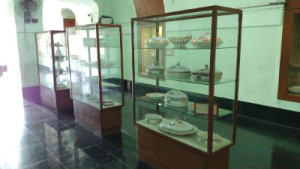 Nobility’s Porcelain
Nobility’s Porcelain
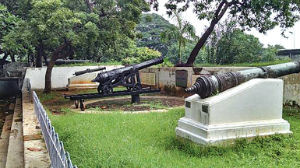 The Gun Garden.
The Gun Garden.

